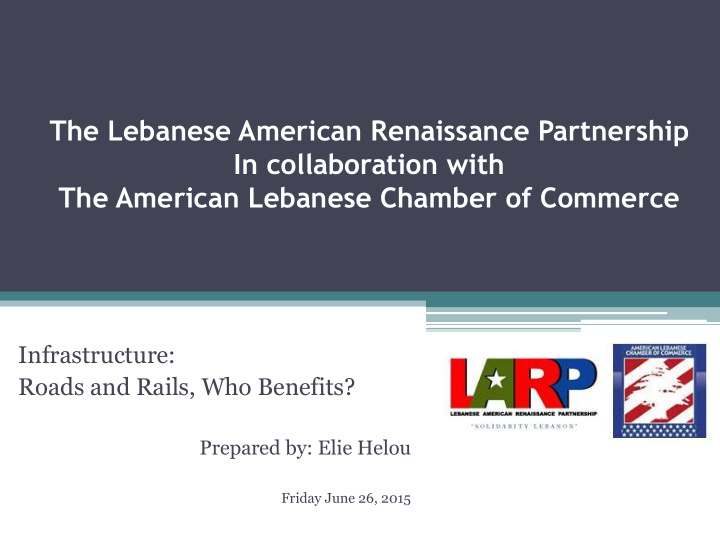



The Lebanese American Renaissance Partnership In collaboration with The American Lebanese Chamber of Commerce Infrastructure: Roads and Rails, Who Benefits? Prepared by: Elie Helou Friday June 26, 2015
Early Roads Roads were the early forms of infrastructure connecting communities and allowing for the transport of people and goods. At that time, humans & animals were the primarily mode of transportation.
Early form of Urban Streets & Squares The first international convention of city planners came to New York in 1898 and they were quick to place the urban horse on the top of their agenda.
Beirut Yesterday 70s 60s 80s 50s
Re-connecting the country Northern entrance After To foster economic growth. Before
Re-Building Beirut Central District To promote social interaction. After Before
Still connecting the country To move people out of Pan Arab Highway: isolation and therefore Jdita Viaduct poverty Eastern Entrance
Transport Sector Development • 2.3 billion $: Investment in the land transport sector since 1993 till 2014. • 250 Million $: Investment in urban transport development Principal Road Highway
Urban Transport Development Project (UTDP) Safety & Mobility were the objectives of the UTDP in Greater Beirut Area. The components of UTDP were: • On-Street Parking management • Traffic management • Urban corridors improvements • Training & awareness
Urban Transport Development Project On- Street parking Management 937 Pay & Display parking meters to manage 7,500 On- street parking spaces
Urban Transport Development Project Traffic Management • 199 traffic lights • 75 CCTV • Traffic signs • Road markings • Pedestrian walkways
Urban Transport Development Project Traffic & On- Street parking Management Traffic Management Center Communication to Traffic lights & CCTV: 45 km network of fiber-optics and DSL technology over twisted pair
Urban Transport Development Project Grade Separations To improve urban corridors, which includes the construction of overpasses & underpasses at 19 intersections Old Saida Rd Mkales Airport Rd Hayek Northern Chiah Blvd Entrance Mazraa Blvd Sodeco
Urban Transport Development Project Grade Separations Hayek Overpass Tayouneh Underpass Dora Overpass
Roads
Key Figures Shared Buses Buses, Taxi and 2.00% 8% Mini Van, 18% Private Cars, 20% Shared Private Taxi, 72% Cars, 80% Greater Beirut Area 1970 Greater Beirut Area 2009
Key Figures 434 /1,000 Ranked 17 th worldwide
Peak Hour or Peak Day Very high level of congestion is recorded on major corridors thought-out most hours of the day
Traffic Management Increased demand in transportation needs has been met with weak provisions of traffic enforcement and …
Public Transport Operation … supply , coverage, quality & operation of Public Transport (PT) Transportation demand remains high & private car dependency keeps increasing Low occupancy of 1.9 in 2009 vs 8.5 in 1970 Prevalence of quantity over quality in licensed PT vehicles concentrated in one region Low passenger occupancy 1.2 /shared taxi & 13/ bus
Down The road GBA Main Arterials in 2035 LOS “E” 1954 LOS “F” 2582 Beirut Ring Road
Greater Beirut Area
Then
Building cities for people not for cars Here are the top ten reasons why: • Diversity • Community • Equity • Health • Economy • Sustainability • Safety • Beauty • Dignity • Connection
New York City Implementation of Bus Rapid Transit (BRT) Reopening of closed rail systems. Better access for cyclists, pedestrians and intermodal transfers A congestion pricing zone for Manhattan south of 86th Street.
Lets Start by
Railroads Advantages Disadvantages • Dependable • Huge Capital Outlay • Better Organized • Lack of Flexibility • High Speed over Long • Lack of Door to Door Distances Service • Suitable for Bulky and • Monopoly Heavy Goods • Unsuitable for Short • Cheaper Transport Distance and Small Loads • Safety • Booking Formalities • Larger Capacity • No Rural Service
Railroad: Beirut – Syrian Borders
GBA and Northern Suburbs Keserwan New Highway 22 km Beirut Ring Road 20km • Planning new highway in Keserwan • Re-designing Beirut Ring Road to include BRT
Beirut Ring road / BRT Line (Concept Design) Beirut Ring Road
BRT Path: Beirut - Tabarja Length of BRT 25 KM Total number of stations 24
Feeders Lines and Park & Ride sites Feeder bus lines increase the willingness to take the BRT by 12%. (9 proposed lines) Park & Ride sites increases the willingness to take the BRT by 14%. (9 proposed sites)
Roads and Rails: who benefits …
Safe and Sustainable Mobility • Enhance road safety by building and maintaining forgiving roads • Reclaim cities back to people by providing sustainable mobility: Rail, BRT, cycling, walking
Recommend
More recommend